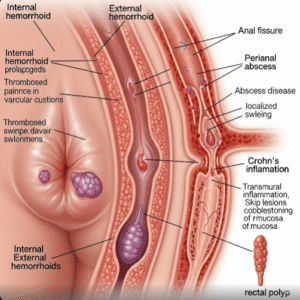Overview
Blurry vision during pregnancy is a common visual change that many expectant mothers experience, typically caused by hormonal fluctuations, fluid retention, or blood sugar variations. While occasional mild blurriness is often harmless, persistent or severe vision changes may signal underlying conditions such as gestational diabetes, preeclampsia, or ocular complications, which require prompt medical attention.
In South Korea, obstetrics and ophthalmology clinics work closely to monitor, diagnose, and manage vision changes during pregnancy, ensuring both maternal and fetal safety.
Key Facts
Highlights:
➡️ Blurry vision may occur at any stage of pregnancy, though it is most common in the second and third trimesters.
➡️ Hormonal changes can temporarily affect the cornea and lens, leading to visual distortion.
➡️ Gestational diabetes or preeclampsia may present with visual disturbances, including blurriness, spots, or flashes.
➡️ Most cases are temporary, resolving postpartum, but persistent vision issues need evaluation.
➡️ South Korea offers comprehensive prenatal care, including specialized eye exams for expectant mothers.
What is Blurry Vision While Pregnant?
Blurry vision during pregnancy is a temporary or recurrent decrease in visual clarity. It can affect one or both eyes, involve near or distance vision, and may be associated with ocular discomfort, headaches, or light sensitivity.
Characteristics include:
- Difficulty focusing on objects at varying distances
- Vision appearing hazy, foggy, or distorted
- Fluctuating visual acuity throughout the day
- Sometimes accompanied by eye dryness or irritation
- Usually resolves after delivery, unless linked to systemic complications
This symptom is considered a normal adaptation in many pregnancies, but it may also serve as a warning for more serious conditions if persistent.
What Symptoms are Related to Blurry Vision While Pregnant?
Symptoms can range from mild to severe depending on the cause:
- Hazy or unclear vision
- Double vision or fluctuating focus
- Headaches or eye strain
- Light sensitivity (photophobia)
- Floaters, flashes, or spots in the visual field
- Swelling of the face or hands may accompany blurriness if related to preeclampsia
- Rapid vision changes may indicate urgent complications
Highlights:
➡️ Temporary blurry vision is common and usually harmless.
➡️ Sudden or severe visual disturbances require immediate medical evaluation.
What Causes / Possible Causes of Blurry Vision While Pregnant?
Highlights:
➡️ Hormonal Changes: Estrogen and progesterone affect corneal thickness and curvature, altering vision.
➡️ Fluid Retention: Pregnancy-related water retention can cause swelling of the cornea, leading to blurriness.
➡️ Gestational Diabetes: High blood sugar levels can temporarily change lens shape, resulting in blurred vision.
➡️ Preeclampsia: High blood pressure during pregnancy can cause retinal changes, vision loss, or flashing lights.
➡️ Dry Eye Syndrome: Hormonal fluctuations reduce tear production, causing visual discomfort.
➡️ Preexisting Eye Conditions: Conditions like myopia, hyperopia, or astigmatism may worsen during pregnancy.
➡️ Migraine-Associated Visual Disturbances: Some pregnant women experience visual aura or blurred vision with migraines.
When Should I See My Doctor?
Highlights:
➡️ If blurry vision is sudden, severe, or accompanied by headaches, swelling, or high blood pressure.
➡️ If floaters, flashing lights, or partial vision loss occurs.
➡️ Persistent or progressive visual changes during pregnancy require ophthalmologic evaluation.
➡️ For signs of gestational diabetes, such as increased thirst, frequent urination, or unexplained fatigue.
➡️ Early consultation helps prevent complications for both mother and baby, including preeclampsia-related vision problems.
Care and Treatment
Management focuses on ensuring maternal and fetal safety while addressing vision changes:
Highlights:
➡️ Regular Eye Check-Ups: Monitoring visual acuity and retinal health.
➡️ Blood Pressure and Blood Sugar Control: Screening for preeclampsia and gestational diabetes.
➡️ Lubricating Eye Drops: Relief for dry eyes and mild discomfort.
➡️ Lifestyle Modifications: Adequate hydration, balanced diet, proper rest, and limited screen time.
➡️ Temporary Vision Correction: Prescription adjustments for glasses if needed, usually deferred until postpartum for stability.
➡️ Medical Intervention: If preeclampsia or gestational diabetes is diagnosed, specialized treatment is initiated to prevent vision-threatening complications.
➡️ Patient Education: Guidance on warning signs such as sudden blurriness, vision loss, or headaches with swelling.
Treatment Options in Korea
South Korea provides advanced prenatal and ophthalmic care for pregnant women with blurry vision:
Highlights:
➡️ Obstetrics Clinics: Monitoring for gestational diabetes, preeclampsia, and overall maternal-fetal health.
➡️ Ophthalmology Services: Eye exams, imaging, and management of pregnancy-related vision changes.
➡️ Multidisciplinary Approach: Collaboration between obstetricians, ophthalmologists, and endocrinologists.
➡️ Prenatal Education Programs: Informing expectant mothers about normal visual changes and warning signs.
➡️ Advanced Diagnostic Tools: Retinal imaging, optical coherence tomography (OCT), and blood sugar monitoring.
➡️ Emergency Care: Rapid response for acute visual changes or preeclampsia-related complications.
➡️ Medical Tourism Support: Multilingual consultations, structured evaluation, and follow-up care for international patients.













